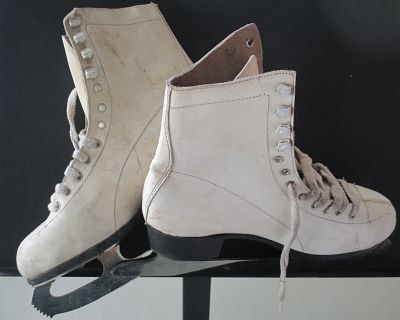NAI roller skates

The first kind of roller skates made had blades and were invented in the Nordic countries for moving on ice. According to certain sources, they were used B.C. (the Common Era), but didn't acquire their current profile until the 19th century (the first blades were made in bone and the skates were hugely uncomfortable). Skates with wheels, however, were created in the 18th century. We must remember that the earliest versions came as a sort of platform to which shoes were attached with straps. Roller skates with boots were invented last century, but before these there were many different models (and probably injuries).
The example we have here is clearly a pair of ice skates, specifically of the classic type (there are another two kinds: hockey and speed). The blade is a single piece of hardened steel, with seven teeth on the front going by the name of 'toe pick’. Although in roller skates this is usually where the brake is located, in ice skating use of the toe pick for this purpose is not recommended and it is normally only used to perform artistic skating moves such as toe loops. The upper part of the ice skates are high white boots, with their original laces. If you look carefully, you can see that the top of the laces are held in place with hooks to allow freedom of movement while holding the foot firmly in place. The boots are made in strong leather to prevent the ankle from twisting. Also worth noting is that the blade is fixed to the boots with screws.
Incidentally, we have noticed the word “ANOETA” written on the under part of the boots, perhaps because the only place with a permanent skating rink in Gipuzkoa is precisely in Anoeta and these skates were used there. But this is only an assumption.
The blade is also engraved, telling us that the piece was made by the Eibar company NAI, the workshop created by Carlos Narbaiza in the ‘50s. This company which occupied different premises in Eibar produced all sorts of articles: skates, skateboards and small automotive parts…
But Carlos Narbaiza did more than that. On retiring he set about acquiring different pieces made in Eibar, creating a collection of enormous value. Bicycles, washing machines, pieces and tools of all sizes, damascene ware, etc., everything has its place in this collection of more than 2,000 pieces. After Carlos died, the family donated the collection to the town council and today work is underway at the Museum to catalogue the items. By means of this piece of the month we wanted to distinguish NAI and its work from all of the companies represented in the collection (Super-Ego, Abelux, Alfa, etc.), and thereby thank Carlos Narbaiza once again for his invaluable help in preserving Eibar’s industrial memory.

